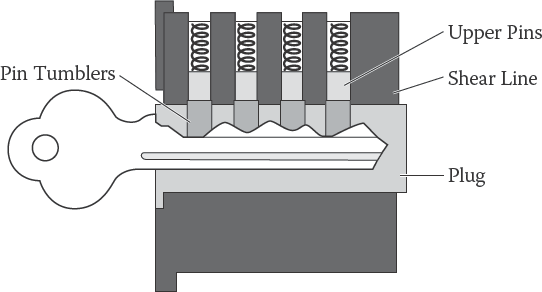7.1. Physical Tools
Physical security is comprised of the measures that companies or people take to remain secure that do not involve a computer. It often involves locks, motion cameras, window sensors, and the like. Understanding physical security and how it works is part of being a good social engineer. You don't have to be an engineer of these devices but having a clear understanding of the security mechanisms a target has in place can help you overcome obstacles that might stand in the way of a successful social engineering audit.
7.1.1. Lock Picks
Before getting into the topic of picking locks you have to know a bit about how a lock works.
Figure 7-1 shows a very rough image of a simple lock.
Figure 7.1. A simple view of a lock.

Basically the way a lock works is that it has tumblers that are manipulated by the key. The key pushes up the tumblers and upper pins, and when they line up it allows the key to turn and unlock the door, server room, cabinet, and so on.
A lock pick simulates the key in moving all the pins into the correct position one by one, allowing the lock to turn freely and open the door. You need two main tools to pick a lock: picks and a tension wrench.
Picks are long pieces of metal that curve at the end, similar to a dentist's tool. They reach inside the lock and move the pins up and down until they are in the right position.
Tension wrenches are small ...
Get Social Engineering: The Art of Human Hacking now with the O’Reilly learning platform.
O’Reilly members experience books, live events, courses curated by job role, and more from O’Reilly and nearly 200 top publishers.

